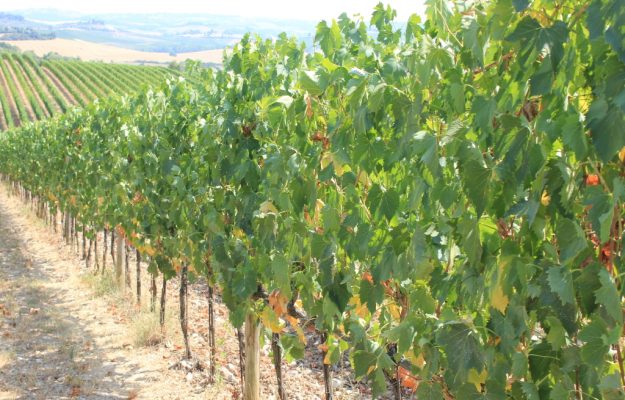The danger comes from the vineyard. In the short term, putting aside for a moment economic headaches, and thus galloping inflation, shortages of raw materials and materials of all kinds, and the labor emergency, the challenge for Italian wine companies, grappling with one of the worst water crises in memory, is all agronomic. A symptom, evident but not the only one, of those climate changes with which the sector has been reckoning for years, not only facing increasingly critical harvests, but also offering solutions in terms of environmental sustainability and, consequently, the fight against CO2 emissions. After all, wine is a product of the earth, and no one knows how to stand up to protect territories like winemakers.
But that’s not enough, because agronomic solutions must necessarily come from research, capable of interpreting a trend that is anything but new, which, as some of the most representative producers of Italian wine told WineNews - from Albiera Antinori (Marchesi Antinori) to Andrea Lonardi (Bertani Domains), from Michele Bernetti (Umani Ronchi) to Raffaele Boscaini (Masi Agricola), from Giampiero Bertolini (Tenuta Greppo) to Cristina Ziliani (Berlucchi), from Luca Rigotti (Mezzacorona) to Stefano Capurso (Dievole), from Christian Ridolfi (Santi - Giv) to Celestino Gaspari (Zymè), from Caterina Dei (Dei) to Tiziano Castagnedi (Tenuta Sant’Antonio), from Antonio Michael Zaccheo (Carpineto) to Giampaolo Speri (Speri), from Francesco Liantonio (Torrevento) to Federica Boffa (Pio Cesare) - translates, over the past 20 years, into every third extreme grape harvest.
Impressive statistics, which concern, just as in this torrid 2022, mainly drought. With which we must learn to reckon, offering, yes, short-term solutions, to safeguard a harvest that promises to fall vertically in terms of quantity (not quality), but also, and above all, a long-term vision. For now, the common opinion has it, a few saving rains would be enough before it is too late and the vine goes into water stress (still a distant scenario).
“Drought is a very worrying issue; we hope, as farmers, that the rain will come again. There is still time to save the vintage, but it is certainly not a good trend”, says Albiera Antinori. While for Andrea Lonardi (Bertani Domains), “drought is the big problem of this period throughout Italy, and in some regions it will be a determining factor in what will be the success of the next harvest”. Urgent solutions are needed, Lonardi continues, establishing, “at the national level a work program that identifies, from the viticultural point of view, short-term objectives that we can achieve, and others in the medium term, which focus on new forms of farming, new varieties, new conditions in which we will be able to do viticulture in a very different perspective from the last 20 years”. Also, according to Michele Bernetti (head of Marche-based Umani Ronchi), “in the immediate term the greatest dangers come from drought, which threatens to break the bank dodo two poor vintages. Maturations are proceeding well, but the risk of major disruptions exists”.
“There is concern about the drought, but working in the primary sector we are used to it: hail, drought, too much rain are eventualities to be taken into account”, recalls Raffaele Boscaini (Masi Agricola), hoping “that it will not lead to disastrous consequences for a vintage that, as of today, promises to be very good, both from the health point of view and for the ripening trend”. At Tenuta Greppo, the home of Biondi Santi’s Brunello di Montalcino, “the problem”, recalls Giampiero Bertolini, “is not new, we have been dealing with it for some time, especially in the structuring of the new vineyards, which in the future should help us to make up for the problem of rising temperatures and, indeed, drought”. In Franciacorta, on the other hand, Cristina Ziliani (Berlucchi) widens the scope of the emergency “to climate change, a challenge we are not prepared for, because we have never experienced one before, and then because it is difficult for humans to control. We are all called upon to do something, at least to limit the damage, but we are too accustomed to well-being to give up habits that would perhaps allow us to slow down this now inescapable process. For an area as small as Franciacorta, climate affects so much, and since 2017, the year of the big frost, the situation has been getting worse and worse. Helping us is technology, especially in the larger, more structured companies. We, for example, have started to introduce Erbamat in the vineyard, a grape variety that should respond well to Climate Change”.
Confident in the positive and propulsive role of the wine supply chain is Luca Rigotti, president of Mezzacorona, who stresses that “climate change is now a fact of life, but the wine sector is working with good sustainability practices directed at reducing the impact of the supply chain on the environment. Being on the production side, this year's drought and the sudden climatic events that have been occurring in recent years may compromise production”. According to Stefano Capurso (Dievole, in Chianti Classico), “climate changes must be included in a long-term vision: we have all been facing them for years, with extreme seasons that have a dramatic influence on wine production. In the last 20 harvests there have been 7 extreme vintages: every three years we are faced with problems of mainly agronomic origin, which need a long-term vision, especially with regard to new plantings, and therefore rootstocks and clones, capable, over time, of calming the negative effects of climate. For some time we have been working on vigorous rootstocks, with very deep root systems, so that our vines have access q those layers of soil that are still moist suffer less from drought. With this in mind, organic viticulture, which we practice in all the appellations where we are present, also helps a lot”.
The situation in Valpolicella is peculiar, recounted by Santi (Gruppo Italiano Vini) oenologist Christian Ridolfi, according to whom “in some areas the emergency is less pressing, as in Valpolicella, a fairly fortunate area, because our vines ripen late and benefit from the coolness and storms of late summer. It is also true that an efficient water network allows us emergency irrigation when needed. However, heat and high temperatures are a stressor, which we can mitigate with work in the vineyard, from managing the foliage wall to protecting the cluster with leaves and limiting excessive evaporation”. Limited actions, which can be overcome with technology, moving the goal a little further without fear of radical interventions: “I am thinking of hybridization to produce drought-resistant vines that know how to root deeper and ripen later. Always protecting the terroir and its history, but giving the appellations the opportunity to adopt different grape varieties and change specifications more nimbly”.
For Celestino Gaspari (Zyme, Valpolicella), who indulges in a digression on the topic, “the number one concern is generational change, because the kids will soon have the steering wheel in their hands, but it doesn’t seem to me that they are so willing to sacrifice and be resilient. Climate Change is another big concern, we’ve been watching it for years and we still don’t know where we might end up. I think deforestation and preying on groundwater resources without rules or ethics are things we will pay for for a long time”. According to Caterina Dei (with an estate in the Montepulciano area), on the other hand, the solution comes through increasingly careful and peculiar vineyard management: “we are increasingly faced with extreme events, so we have to manage the vineyard by focusing on each individual plot and choosing the practices capable of making each variety and each vineyard express itself at its best. For us, in an organic regime, the difficulties are even greater, we will have to take into account smaller quantities, but to produce more and more quality wines”. Tiziano Castagnedi (Tenuta Sant’Antonio, in Valpolicella) emphasizes the “normality” of exceptionalism, recalling that “in recent decades we have become accustomed to climate change and to dealing with summer droughts and often spring frosts”. At the same time, for Antonio Michael Zaccheo (with wineries in Montalcino, Montepulciano and Chianti Classico), “climate change is a serious problem, requiring global collaboration”. Starting with an assumption, well summarized by Giampaolo Speri (Speri, Valpolicella): “the vine has an incredible spirit of adaptation, and today there are strategies that, from a viticultural point of view, can help us”.
Finally, the words of Francesco Liantonio (Torrevento, in Castel del Monte, Apulia), according to whom that of drought, and therefore Climate Change, “is not an easy problem to face and solve. It is a matter of conscience, first of all of us producers: we must take a real path toward sustainability, in deeds, not in words. Good or bad, it is a problem we are dealing with, unlike economic dynamics, such as inflation and lack of raw materials, problems that leave us dismayed”. Federica Boffa (Pius Caesar), then, concludes by recalling the dramatic situation in the Langhe (but more generally in Piedmont, ed.), where “we did not record much precipitation during the winter, when we had only one day of snow. We are coming from more than 100 days without water, and this is not helping us face an unprecedented summer. Nebbiolo is struggling a lot, as are all the other most important grape varieties in our region, from Barbera to Dolcetto, but also Chardonnay and Sauvignon, and this worries us a lot ahead of the harvest. We had a few days of relief with some nice rainy days, accompanied, however, by hail, which certainly did not help us. Yet, perhaps exaggerating, we are even willing to sacrifice a few grapes for a little rain. The 2022 vintage, thus, will be characterized by sharply declining quantities, but we hope for high quality, precisely because of the naturally low yields”.
Copyright © 2000/2026
Contatti: info@winenews.it
Seguici anche su Twitter: @WineNewsIt
Seguici anche su Facebook: @winenewsit
Questo articolo è tratto dall'archivio di WineNews - Tutti i diritti riservati - Copyright © 2000/2026


























































































































































































